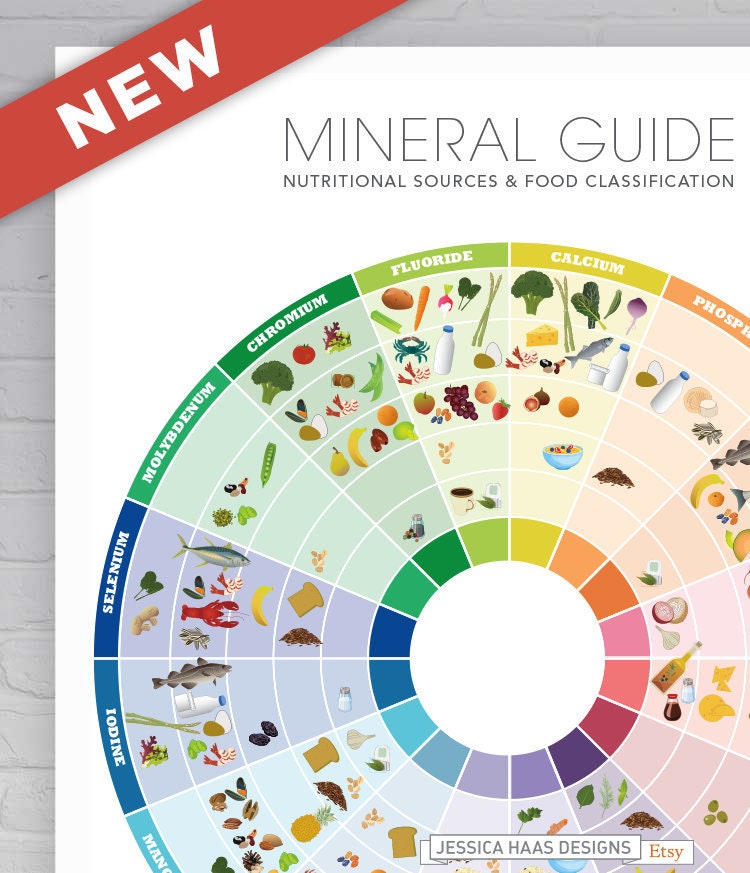43 minerals on food labels
How to Read Supplement Labels Like a Pro - Healthline Ingredients. When selecting a supplement, reading the ingredient label is key. Check carefully for ingredients like fillers, sweeteners, preservatives, and additives, all of which will be listed ... Food Labels (for Teens) - Nemours KidsHealth A food with 10%-19% of a nutrient is a good source of that nutrient. A food with 20% or more of a nutrient is high in that nutrient. The information on food labels is based on an average adult diet of 2,000 calories per day. The actual number of calories and nutrients that kids need will depend on their age, weight, gender, and level of ...
Dietary Supplement Labeling Guide: Chapter IV - FDA This results in the following order for vitamins and minerals: Vitamin A, vitamin C, vitamin D, vitamin E, vitamin K, thiamin, riboflavin, niacin, vitamin B6, folate, vitamin B12, biotin,...

Minerals on food labels
7 Presentation of Nutrition Information on Food Labels On the food label, the percentage of U.S. RDA is "a statement of the amount per serving (portion) of the protein, vitamins, and minerals." According to FDA regulations, U.S. RDA percentages are expressed in 2 percent increments up to the 10 percent level, 5 percent increments from 11 to 50 percent levels, and 10 percent increments above the 50 ... Understanding Nutrition Facts on Food Labels - WebMD The label tells you it has no fiber or any of the key nutrients: vitamins A or C, iron and calcium. You'll notice different units of measurement on food labels. Many of the nutrients are measured... Where are the vitamins and minerals on a nutrition labels? The Nutrition Facts label may include the following 14 minerals: Calcium, chloride, chromium, copper, iodine, iron, magnesium, manganese, molybdenum, phosphorus, potassium, selenium, sodium, and zinc are some of the minerals found in the human body. On a nutrition label, how are ingredients listed?
Minerals on food labels. The 10 Ways Nutrition Labels Help You Make Healthy Choices All food labels list percent daily value of calcium, iron and vitamins A and C. To meet requirements, select foods that provide 20 percent or more of the daily value of these vitamins and minerals.... Minerals In Food - Definition, Types, Sources and Examples There are many examples of minerals in food; these include: Calcium Phosphorus Potassium Sodium Iodine Iron Magnesium The body also requires other minerals in trace amounts such as selenium, cobalt and molybdenum. These elements are known to a specific function in the human body. Types of Minerals in Food Food Labels | Nutrition.gov Folate and Folic Acid on the Nutrition and Supplement Facts Labels HHS, Food and Drug Administration, Center for Food Safety and Applied Nutrition Learn what common foods are natural sources of the vitamin folate, plus what foods may have folic acid added during processing. Interactive Nutrition Facts Label HHS, Food and Drug Administration Understanding Nutritional Labels - Beaumont Health Most food labels won't list many vitamins and minerals and will instead just list a few. If the food you're looking at doesn't have any (or many) vitamins or minerals, you might want to consider something else. Each label will also include the percent of recommended daily value for each of the above. So you will be able to see how many ...
Food labeling: MedlinePlus Medical Encyclopedia VITAMINS AND MINERALS Vitamin D, calcium, iron, and potassium are the only micronutrients required to be on the food label. Food companies can voluntarily list other vitamins and minerals in the food. PERCENT DAILY VALUE (% Daily Value) Many nutrients include a percent daily value (%DV). Interactive Nutrition Facts Label - Accessdata.fda.gov Changes to the Nutrition Facts Label | FDA The updated label appears on the majority of food packages. Manufacturers with $10 million or more in annual sales were required to update their labels by January 1, 2020; manufacturers with less ... Understanding Food Labels - Nutrition: Science and Everyday Application The FDA uses the following definitions for interpreting the %DV on food labels:4 5%DV or less means the food is low in a nutrient. 10% to 19%DV means the food is a "good source" of a nutrient. 20%DV or greater means the food is high in a nutrient.
Optional Nutrients On The Food Label - LabelCalc What Nutrients are Optional on the Food Label: Voluntary Nutrition Information. Gregory was thoroughly confused. He'd finished perfecting the recipe for his protein-packed energy bars, which he'd been selling at the local Farmers Market for the past year. ... While the FDA requires that some specific vitamin, mineral, and macronutrient ... Understanding Food Nutrition Labels | American Heart Association Make sure you get enough of the nutrients your body needs, such as: calcium, choline, dietary fiber, iron, magnesium, potassium, and vitamins A, C, D and E.* 5 - Understand % Daily Value. The % Daily Value (DV) tells you the percentage of each nutrient in a single serving, in terms of the daily recommended amount. Interactive Nutrition Facts Label - Food and Drug Administration Sodium 430mg 17% Total Carbohydrate 46g 25% Dietary Fiber 7g Total Sugars 4g 4% Includes 2g Added Sugars Protein 11g 10% Vitamin D 2mcg 20% Calcium 260mg 35% Iron 6mg 6% Potassium 240mg The % Daily... Interactive Nutrition Facts Label - Vitamins and Minerals There are 14 minerals that may be listed on the Nutrition. Facts label: calcium, chloride, chromium, copper, iodine, iron, magnesium, manganese, molybdenum, ...2 pages
PDF Interactive Nutrition Facts Label - Vitamins and Minerals Chart wwwaovnutritioneucation Vitamins and Minerals Chart 1 Vitamins. VITAMIN WHAT IT DOES. WHERE IT IS FOUND DAILY; VALUE* Biotin ... • Conversion of food into energy • Digestion • Fluid balance • Nervous system function Olives ... Interactive Nutrition Facts Label - Vitamins and Minerals Chart
Nutrition Facts Labeling — FDA Reader Macronutrients & Minerals (In order) Calcium Iron Phosphorus Iodine Magnesium Zinc Selenium Copper Manganese Chromium Molybdenum Chloride Potassium Vitamins and minerals must appear in the label if: They appear in a serving of the product When they are added as a nutrient supplement When a claim is made about them
New Food Label Spotlight: Vitamins and Minerals In the updated label, that same section will jettison vitamin A and vitamin C (the FDA asserts, "In the early 1990's, American diets lacked Vitamins A and C, but now Vitamins A and C deficiencies in the general population are rare"), replacing them with vitamin D and potassium. Calcium and iron will remain on the label.
Nutrition Labeling - The Sugar Association The goal of the Food and Drug Administration's (FDA) Nutrition Fact Label is to "ensure consumers have access to the information they need to make informed decisions about the foods they eat." 1 All Nutrition Facts Labels are required to include an Added Sugars declaration beginning January 1, 2020 for manufacturers with >$10 million in sales and January 1, 2021 for manufacturers with ...
Vitamin, mineral daily requirements and good food sources -- Harvard ... RDAs, food sources for selected vitamins and minerals October 1, 2013 Recommended Dietary Allowances (RDAs) for selected nutrients commonly displayed on food labels
Nutrition Labels 101: What's Required? What's Optional? 5. Trans Fat. Trans fat is the worst of the "bad fats," which is why in 2006 the FDA began requiring it to be listed separately on nutrition labels. Trans fat, like saturated fat, increases LDL cholesterol levels (i.e., "bad" cholesterol) but also lowers HDL cholesterol levels (i.e., "good" cholesterol). So it's a bit of a ...
Vitamins and Minerals | Nutrition.gov Interactive Food Label: Vitamins and Minerals. HHS, Food and Drug Administration, Center for Food Safety and Applied Nutrition. How can the Nutrition Facts label help you to choose foods rich in vitamins and minerals? Use this interactive resource to find out! Vitamins and Minerals Chart ...
How To Read Food and Beverage Labels | National Institute on Aging There are three types of product dates commonly printed on packaged foods and beverages: "Sell by" tells how long the manufacturer suggests that a store should sell items such as meat, poultry, eggs, or milk products. Make sure you buy by this date. "Use by" tells how long items will be at peak quality.
Nutrient Claims on Food Labels | Home & Garden Information Center Sodium content cannot exceed 360 mg per serving for individual foods and 480 mg per serving for meal-type products. If a food is labeled "healthy" or makes a health claim, it cannot contain any nutrient that increases the risk for disease. It must contain no more than 20% of the DV per serving of total fat, saturated fat, cholesterol, or sodium.
Food Labels: Carbohydrates | Home & Garden Information Center Facts on Food Labels. Food labels contain clues to a food's carbohydrate content, including the amount per serving. ... (% DV) for total carbohydrate, dietary fiber, vitamins and minerals. The label does the math for you, putting all the numbers on the same scale of 0-100% DV for the day. These percentages are based on a 2,000-calorie daily ...
Understanding Food Labels | The Nutrition Source | Harvard T.H. Chan ... Under the Food Allergen Labeling and Consumer Protection Act of 2004, eight major food allergens—milk, fish, tree nuts, peanuts, shellfish, wheat, eggs, and soybeans—are required to be listed in a "contains" statement near the Ingredients list if present in a food. An example would be "contains wheat, milk, and soy."
Food Labels | CDC In general, eat more foods that are higher in vitamins, minerals (such as calcium and iron), and fiber. Eat fewer foods that are higher in added sugars, saturated fat, and sodium (salt), and avoid trans fat. Keep in mind that the % Daily Value of each nutrient, such as total fat of 10% in the example below, is based on eating 2,000 calories a day.
Where are the vitamins and minerals on a nutrition labels? The Nutrition Facts label may include the following 14 minerals: Calcium, chloride, chromium, copper, iodine, iron, magnesium, manganese, molybdenum, phosphorus, potassium, selenium, sodium, and zinc are some of the minerals found in the human body. On a nutrition label, how are ingredients listed?
Understanding Nutrition Facts on Food Labels - WebMD The label tells you it has no fiber or any of the key nutrients: vitamins A or C, iron and calcium. You'll notice different units of measurement on food labels. Many of the nutrients are measured...
7 Presentation of Nutrition Information on Food Labels On the food label, the percentage of U.S. RDA is "a statement of the amount per serving (portion) of the protein, vitamins, and minerals." According to FDA regulations, U.S. RDA percentages are expressed in 2 percent increments up to the 10 percent level, 5 percent increments from 11 to 50 percent levels, and 10 percent increments above the 50 ...










Post a Comment for "43 minerals on food labels"